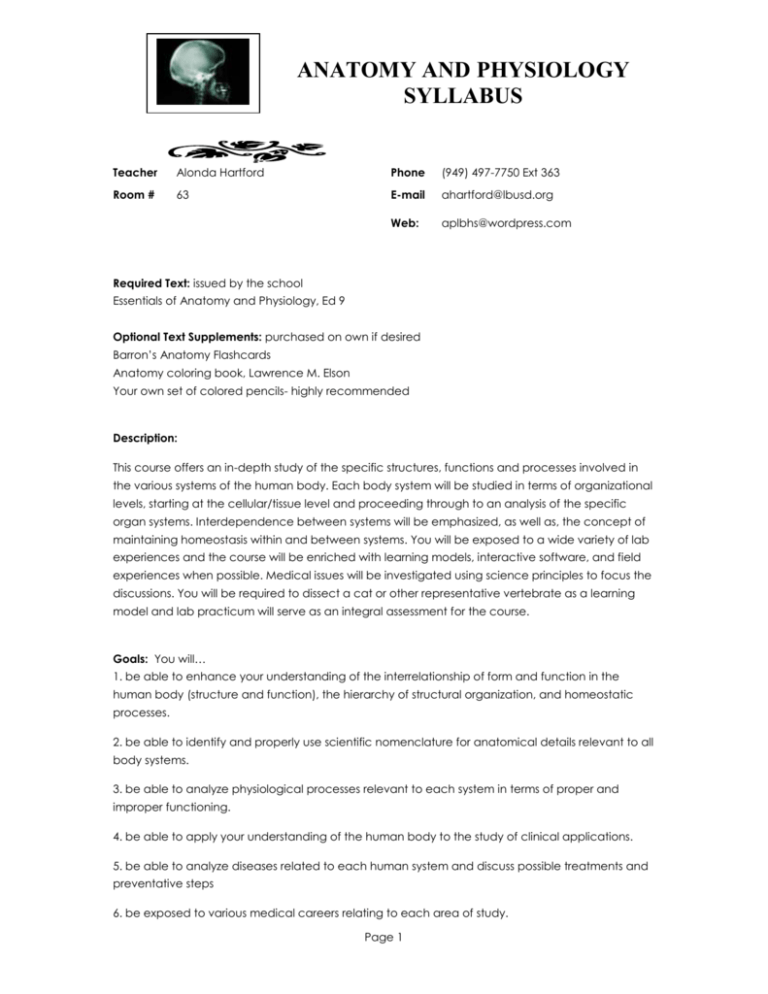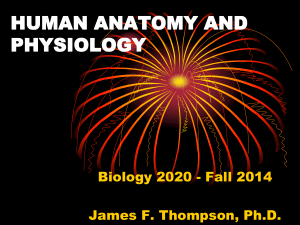Anatomy and Physiology Syllabus
advertisement

ANATOMY AND PHYSIOLOGY SYLLABUS Teacher Alonda Hartford Phone (949) 497-7750 Ext 363 Room # 63 E-mail ahartford@lbusd.org Web: aplbhs@wordpress.com Required Text: issued by the school Essentials of Anatomy and Physiology, Ed 9 Optional Text Supplements: purchased on own if desired Barron’s Anatomy Flashcards Anatomy coloring book, Lawrence M. Elson Your own set of colored pencils- highly recommended Description: This course offers an in-depth study of the specific structures, functions and processes involved in the various systems of the human body. Each body system will be studied in terms of organizational levels, starting at the cellular/tissue level and proceeding through to an analysis of the specific organ systems. Interdependence between systems will be emphasized, as well as, the concept of maintaining homeostasis within and between systems. You will be exposed to a wide variety of lab experiences and the course will be enriched with learning models, interactive software, and field experiences when possible. Medical issues will be investigated using science principles to focus the discussions. You will be required to dissect a cat or other representative vertebrate as a learning model and lab practicum will serve as an integral assessment for the course. Goals: You will… 1. be able to enhance your understanding of the interrelationship of form and function in the human body (structure and function), the hierarchy of structural organization, and homeostatic processes. 2. be able to identify and properly use scientific nomenclature for anatomical details relevant to all body systems. 3. be able to analyze physiological processes relevant to each system in terms of proper and improper functioning. 4. be able to apply your understanding of the human body to the study of clinical applications. 5. be able to analyze diseases related to each human system and discuss possible treatments and preventative steps 6. be exposed to various medical careers relating to each area of study. Page 1 7. be able to enhance your understanding of the human body systems using dissection of a small mammal as a model 8. be able to develop their conceptual framework, factual knowledge, and analytical skills necessary to deal critically with the rapidly changing field of human anatomy and physiology. Class Materials: Bring to class everyday: - notebook: three-ring binder with dividers, plenty of loose-leaf paper - pen/pencil - colored pencils (optional but useful) Evaluation: Mind sets: - given at the beginning of class - may be graded as quiz if review of material Homework: - Homework is assessed using the following methods: • % correct – used if assignment is a review/reinforcement of covered material and mastery is expected • % completion – used if assignment introduces a new topic or is used as practice of a new skill -All homework is to be completed by the BEGINNING of the next class period, unless noted otherwise by the teacher. Lab Reports/Case studies: - Certain lab activities and case studies will require a formal written report. - The specified lab format and grading criteria will be taught and reviewed before each lab is due. - Written reports are approximately 100 points each. Quizzes: - Announced and unannounced quizzes will be given at teacher discretion. - Quiz point values will vary between 5-25 points. Chapter/Unit Exams: - Always announced - Align with learning objectives covered in class and state content standards - Exams are corrected and answers are reviewed with class. Student reflections are required after the review of each exam. - Exam point values vary between 50-100 points. Extra Credit: - Challenge questions on exams. - Cooperative learning activities. Semester Finals: - Administered in accordance with school/district policies. Approx. 200-250 points Page 2 Make-up Work – your life will be easier if you don’t miss class! If absent from class for an excused absence: when you return do the following before class begins: 1. Go to the “what you missed” area to obtain handouts and review class log for the class agenda. Attach the “Absent work” slip to new homework. Newly acquired homework must be completed and turned in before the next class period. 2. See teacher right away to turn in homework that was due while you were out and/or to set up a time to make up tests, labs or any other missed work. 3. All work that was due on the day of your absence is due immediately upon your return. 4. If you are absent on the day of an exam: • An alternative exam will be given upon your return – essay exams that align with the same learning objectives and standards may be administered as the alternative exam. • The date and time for the make-up exam will be determined by the teacher with input from the student – this date is final. Failure to make-up the exam on the established date will result in a zero on the exam. 5. If you are absent on the day of a lab: • An alternative assignment may be given due to availability of supplies and time required for set-up. The alternative assignment will align with the same learning objectives covered during the lab. • The date and time for the make-up lab or alternative lab assignment will be determined by the teacher with input from the student – this date is final. Failure to make-up the lab or lab assignment will result in a zero for the lab activity. Classroom Rules: Policies and procedures for the class will be established in a collaborative effort by teacher and students. Students will agree in writing to abide by the classroom policies or face established consequences as specified in the behavioral agreement. • No cell phones or personal electronics to be used during class. Cell Phones will be checked-in and checked-out every class period. • No unauthorized dissections Golden Rule! Steps for Success: • Attend and actively participate in class activities and discussions • Take good notes and stay organized • Complete all assignments on time • Ask questions to ensure understanding • Use SDL (student directed learning) and see me for extra help if needed Page 3 TOPICS COVERED IN ANATOMY AND PHYSIOLOGY Instructional Units SEMESTER 1 Introduction to the Human Body Define Anatomy and Physiology Describe each of the levels of structural organization that make up the human body List and define the necessary life functions in humans Define homeostasis and disease Describe how negative and positive feedback mechanisms help to maintain homeostasis. Give physiological examples. Cellular Physiology Cell structures and functions Maintaining homeostasis Cell to cell communication Integumentary System Explain how the skin is considered an organ and describe its functions Describe the histological characteristics of the epidermis, dermis and hypodermis List and describe the different cell types of the epidermis Skeletal System Discuss the functions of bone Describe the chemical composition of bone Differentiate between osteoprogenitor cells, osteoblasts, osteocytes, and osteoclasts Describe the structure of a long bone Compare the histological characteristics of spongy bone and compact bone Nervous System Neuron anatomy Neural classification Neurophysiology – sodium/potassium pumps Peripheral and Central nervous systems Autonomic nervous system Muscular System List the major functions of the muscular system Describe the gross and microscopic structure of skeletal muscle Explain the structure of a sarcomere Examine the events involving neuromuscular transmission of the action potential Describe the specific actions of acetylcholine and acetylcholinesterase Define motor neuron, motor unit, and recruitment Define muscle tone and discuss the cause and function SEMESTER 2 Endocrine System State the major functions of the endocrine system List and locate the major endocrine organs in the human body Define hormone, target organs, and hormone receptors Describe the structural and functional relationship between the hypothalamus and pituitary gland List the hormones of the anterior lobe of the pituitary and their functions List the hormones stored in the posterior lobe of the pituitary and their functions List the hormones produced by the adrenal glands (cortex and medulla) and their functions Cardiovascular System List the functions of blood, blood cell types Review the anatomy of the human heart Page 4 Review the route of blood flow through the systemic and pulmonary circuits Define heart rate, stroke volume and cardiac output; discuss their relationship List and describe the factors affecting heart rate Describe the three layers (tunics) that typically form the wall of a blood vessel Compare and contrast the structure and function of arteries, arterioles, capillaries, venules, and veins Respiratory System Review the structure and function of the organs of the respiratory system Describe Boyle’s Law and explain how it relates to lung function Describe the events that lead to inspiration and expiration (pressure and volume changes) Describe the structure and function of the respiratory membrane Describe partial pressure in a gas mixture Describe how oxygen is transported in the blood and explain the influence of PO2 on hemoglobin Digestive System List the functions of the digestive system Describe the general histology of the gastrointestinal tract Describe digestion in the mouth (mechanical and chemical) Describe the structure and function of the esophagus Describe the structure and functions of the stomach List the cell types in the stomach Identify the regions and function of the small intestine List the functions of the liver and gall bladder State the roles of pancreatic juice and bile in digestion Describe the structure and functions of the large intestine Renal Physiology Describe the structure of the kidney and of the nephron Describe path of blood supply to the nephrons Describe the process of urine formation through glomerular filtration, tubular reabsorption and tubular secretion List the hormones involved in sodium, potassium and water balance and explain their functions Discuss the roles of the kidneys in acid-base balance and fluid and electrolyte balance Reproductive System Discuss the determination of genetic sex and prenatal development of male and female structures Define puberty and secondary sexual characteristics Describe the functions of LH, FSH, testosterone and inhibin in the male Describe the process of oogenesis and compare it to spermatogenesis Describe the functions of LH, FSH, estrogen, progesterone and inhibin in the female Outline the major events of each phase of the uterine (menstrual) cycle and correlate them with the events of the ovarian cycle Describe the effects of aging on the reproductive systems Page 5








